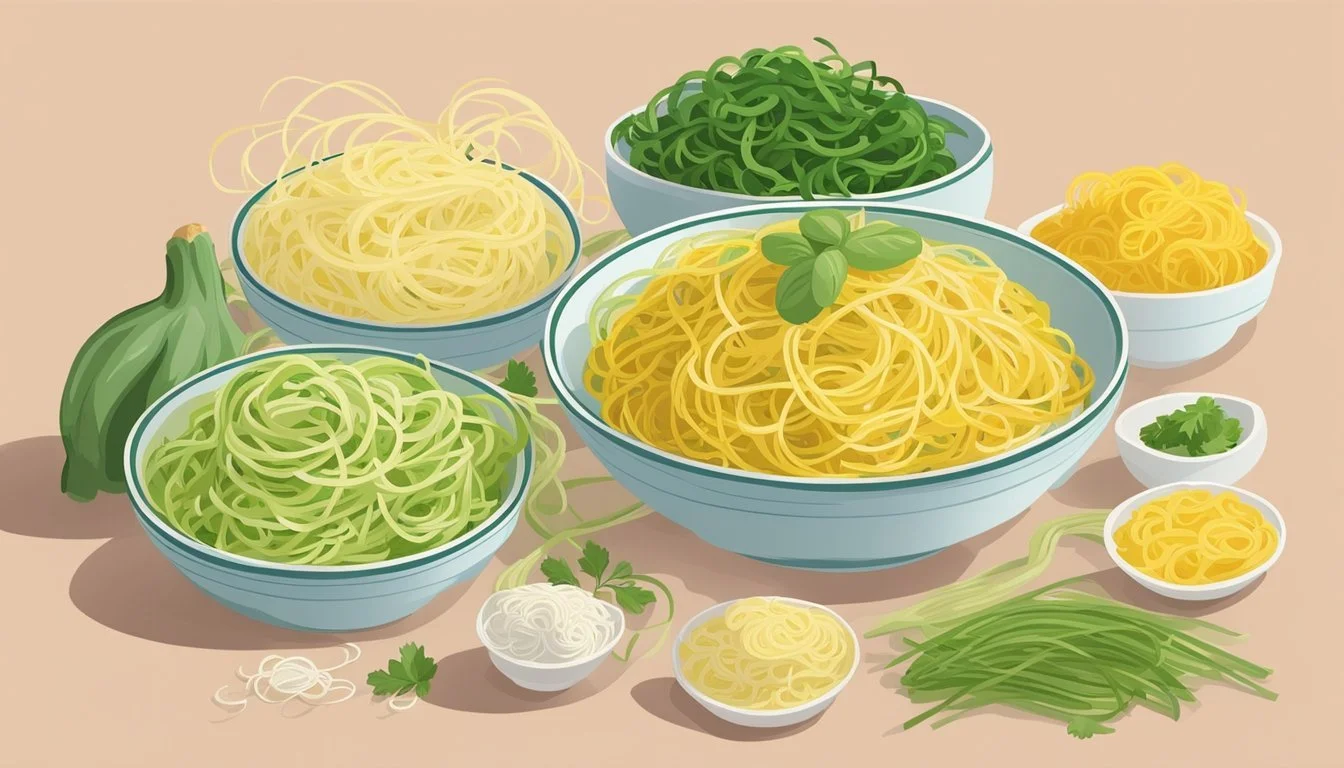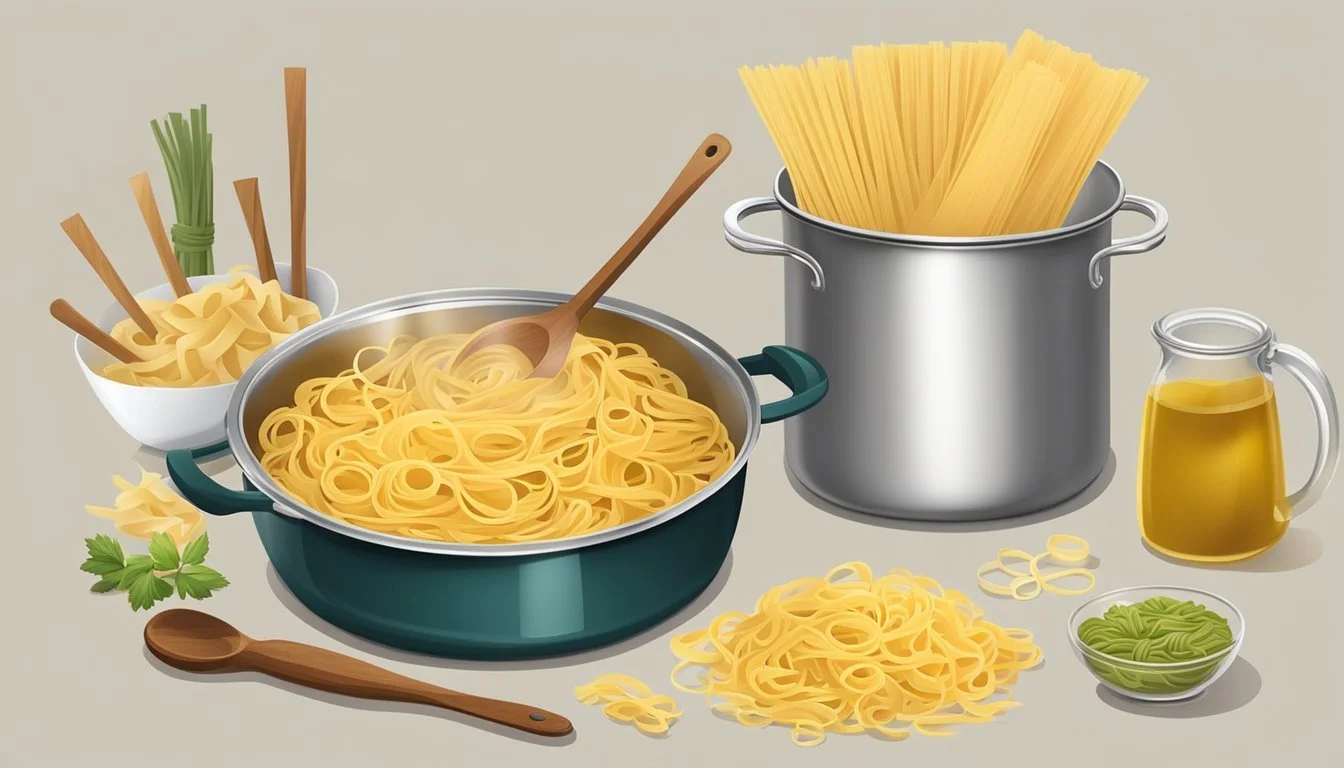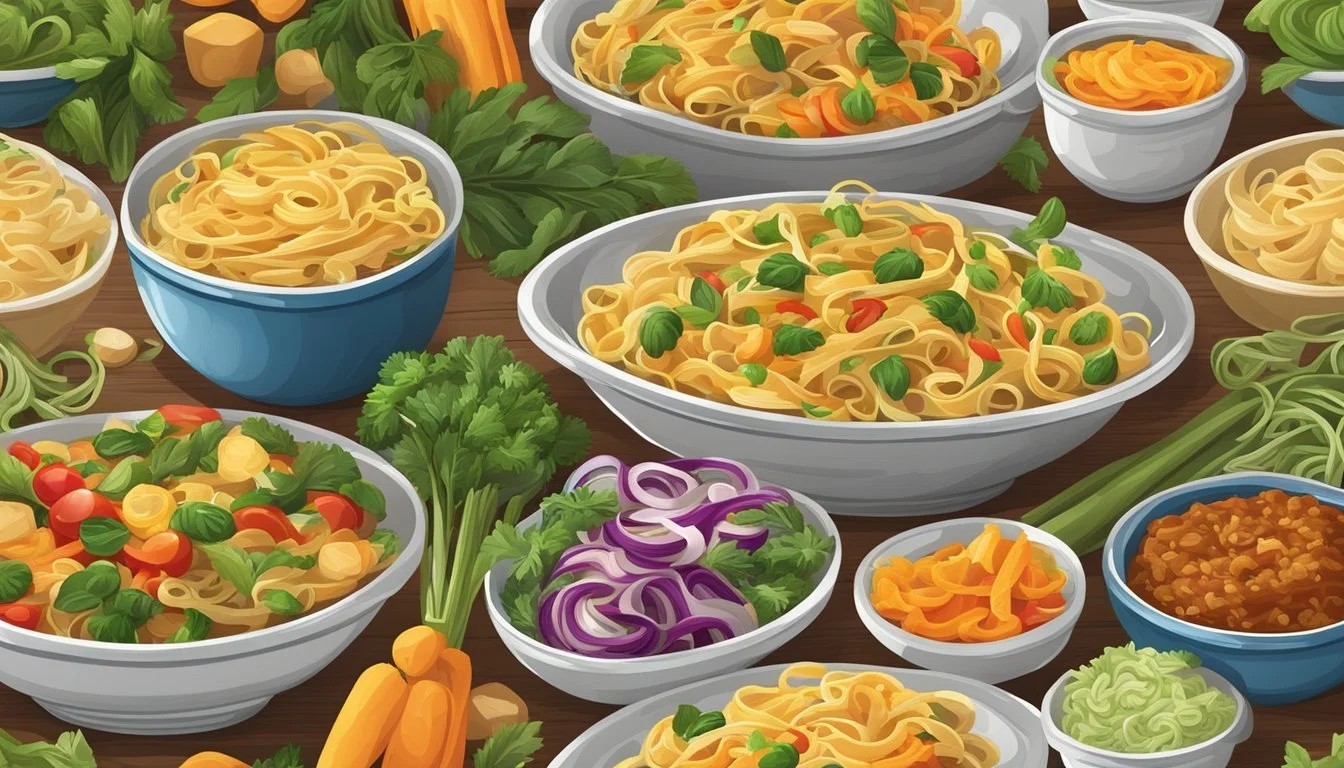Fettuccine Pasta Substitutes
Top Alternatives for Your Italian Dishes
Fettuccine pasta (What wine goes well with pasta?), with its flat and thick strands, is a staple in Italian cuisine, often served tossed in Alfredo sauce or other hearty meat sauces. However, dietary restrictions or simply a lack of fettuccine at hand can necessitate the search for suitable alternatives. The texture and size of fettuccine make it unique, but there are several options available that can mimic its characteristics in a dish.
Exploring different pasta substitutes often leads to new and exciting flavors and textures. Long, thin rice noodles can cater to those who are gluten intolerant, offering a slightly sweet taste and delicate texture that pairs well with a variety of sauces and ingredients. Other wheat-based noodles like tagliatelle and pappardelle also make excellent substitutes, providing a similar mouthfeel with slight variations in width and texture to accommodate different types of sauces.
For those looking for not just a different pasta but a healthier option, whole wheat pastas are rich in fiber and contribute a denser texture and nuttier flavor. They can beautifully replace fettuccine in most recipes without sacrificing the integrity of the dish. Adaptable and versatile, these substitutes ensure that the essence of the beloved fettuccine dishes can still be enjoyed, regardless of dietary preferences or availability of ingredients.
Understanding Fettuccine Pasta
Fettuccine, a staple in Italian cuisine, is distinguished by its flat and thick noodles, traditionally crafted from egg and durum wheat semolina.
History and Characteristics
Fettuccine has its origins in Italian cuisine, specifically from the regions of Marche and Emilia-Romagna. These ribbons of pasta measure approximately 6.5 millimeters in width and are known for their flat and thick nature, allowing them to hold onto robust and creamy sauces effectively.
Key Characteristics:
Shape: Flat and thick ribbons
Width: Approximately 6.5 millimeters
Ingredients: Traditionally made with egg and durum wheat semolina
Regional Origin: Marche and Emilia-Romagna, Italy
Nutritional Profile
Fettuccine's primary ingredients, egg and durum wheat semolina, impart a significant amount of protein and carbohydrates, making it an energy-rich food. The addition of eggs enriches the pasta with additional protein and lends a delicate flavor and a tender texture.
Basic Nutritional Information (per 100g of cooked fettuccine):
Calories: Approximately 160 kcal
Protein: 5.8 g
Carbohydrates: 31.0 g
Fiber: 1.9 g
Fat: 1.3 g
This pasta, while rich in energy, also offers a modest amount of dietary fiber and is low in fat.
Common Pasta Substitutes
When searching for an alternative to traditional fettuccine, individuals often turn to vegetable-based or grain and legume-based substitutes. These options offer a range of textures and flavors that cater to various dietary requirements and taste preferences.
Vegetable-Based Substitutes
Vegetable-based pasta alternatives are gaining popularity for their health benefits and lower calorie content. Common options include:
Zucchini Noodles: Also known as "zoodles," these are made by spiralizing zucchini into long strings. They provide a pasta-like experience with a fraction of the calories and are rich in vitamins.
Spaghetti Squash: Upon cooking, the flesh of this squash separates into strands resembling spaghetti. It's a nutritious and gluten-free substitute that pairs well with a variety of sauces.
Shirataki Noodles: Made from the konjac plant, these translucent and gelatinous noodles are almost zero-calorie and can be a suitable swap for fettuccine in many dishes.
Grain and Legume-Based Substitutes
Substitutes made from grains and legumes offer a texture closer to traditional pasta and sometimes provide a higher protein content:
Chickpea Pasta: This substitute is made from chickpea flour and provides a high-protein, gluten-free alternative to fettuccine. It has a firm texture and a nutty flavor, serving as a hearty base for sauces.
Rice Noodles: Made from rice flour, these noodles come in various thicknesses. While they can be used in a multitude of dishes, they have a subtly sweet flavor and are a good choice for those avoiding gluten.
Including these substitutes in one's diet can maintain the satisfaction of a pasta meal while accommodating dietary restrictions or simply providing a nutritious twist to traditional recipes.
Health Considerations of Substitutes
When exploring fettuccine pasta substitutes, two primary health considerations come to the forefront: gluten content for those with sensitivities and the balance of carbohydrates for individuals monitoring their intake for dietary reasons.
Gluten-Free Options
Gluten intolerance and celiac disease necessitate the exclusion of gluten from the diet. Gluten-free pasta options offer a viable alternative, being made from ingredients like rice flour or legumes such as chickpeas and lentils. Rice noodles, a staple in Asian cuisine, serve as an excellent gluten-free substitute for fettuccine, providing a similar texture with a slightly sweet flavor profile. Legume-based pastas not only eliminate gluten but also enhance nutritional value with increased protein and fiber.
Advantages of gluten-free pasta:
Suitable for those with gluten intolerance or celiac disease
Often high in additional nutrients like protein and fiber
Low-Carb and Low-Calorie Choices
For individuals seeking to reduce their carbohydrate intake or manage their calorie consumption, low-carb pasta substitutes can play a significant role in maintaining a balanced diet. Pastas made from beans or other alternatives typically contain fewer carbohydrates than their wheat-based counterparts, contributing to a lower calorie count. Substitutes such as spiralized vegetables like zucchini provide a pasta-like experience while drastically cutting down on calories and carbohydrates.
Notable low-carb and low-calorie substitutes:
Spiralized vegetables (carbohydrates: minimal, calories: low)
Legume-based pastas (carbohydrates: reduced, calories: moderate)
By choosing the right pasta substitute, individuals can address their health requirements without compromising on the enjoyment of their meals. Whether the priority is to avoid gluten or to reduce carbohydrate and calorie intake, there are various options available that offer both health benefits and culinary versatility.
Texture and Flavor Adaptations
In selecting fettuccine pasta substitutes, one must consider how closely alternative noodles mimic the original's texture and flavor. The goal is to achieve a similar culinary experience with a satisfactory bite and familiar taste.
Achieving Similar Texture
When replacing fettuccine, it's essential to find noodles that offer a comparable al dente quality.
Tagliatelle: They provide a firm texture with a slightly rough surface, much like fettuccine but slightly broader.
Rice Noodles: These thin, translucent noodles have a different bite but can substitute for fettuccine's texture in dishes where a softer noodle is acceptable.
Whole Wheat Pasta: Offers a denser texture, ensuring a hearty bite that stands up well in robust sauces.
Maintaining Flavor Profiles
The substitution should not only feel right but also taste right.
Rice Noodles: With their subtly sweet flavor, rice noodles are an excellent gluten-free alternative that complements the flavors of fettuccine-based dishes.
Whole Wheat Pasta: Boasts a nutty flavor, enriching dishes with a more pronounced taste profile.
Egg Noodles: Can be used in recipes like Carbonara to maintain the rich, savory essence of traditional fettuccine.
Cooking Methods and Times
When substituting fettuccine, it's important to consider the adjustments in cooking methods and times to achieve the perfect texture and flavor. Proper preparation ensures the alternative pasta pairs well with the desired sauces and ingredients.
Boiling and Baking Adjustments
Rice Noodles: They require boiling water but have a shorter cooking time compared to traditional pasta. Typically, rice noodles are cooked in hot water for just 3-5 minutes. In baked dishes, they should be pre-soaked and then baked according to the recipe.
Whole Wheat Pasta: It generally requires a longer boiling time to reach an al dente texture, often between 10-15 minutes. When used as a substitute in baked recipes, whole wheat pasta should also be pre-cooked to ensure it doesn’t become too firm.
Stir-Frying and Roasting Options
Linguine: While replacing fettuccine in stir-fries, linguine requires similar cooking times, ranging from 9-11 minutes in boiling water. It stands up well in stir-fries due to its similar thickness and robust nature.
Vegetable Noodles: For a healthier take, vegetables can be spiralized and briefly stir-fried for 1-2 minutes or until barely tender. They are not typically roasted, as they are best enjoyed with a slight crunch.
Sauce Pairing and Recipe Adaptation
When substituting fettuccine pasta, it is essential to consider how the alternative pasta shapes will interact with the sauces and their consistency. The utilitarian aspect of pasta as a sauce delivery vehicle must be in harmony with the physical characteristics of the substitutes.
Selecting Complementary Sauces
Rice Noodles: Ideal for lighter sauces such as pesto or tomato-based sauces due to their delicate structure.
For example, Rice Noodles with Marinara: The subtle sweetness of rice noodles pairs well with the tanginess of a classic marinara.
Tagliatelle: Thicker and heartier than fettuccine, tagliatelle can carry heavier sauces like bolognese.
Tagliatelle with Alfredo: Its broader surface and more pronounced texture provide excellent sauce adherence for creamy sauces like alfredo.
Pappardelle: Wider still, pappardelle is best matched with even heavier sauces that feature large pieces of meat or vegetables.
Pappardelle with Ragú: The width and texture make it a suitable choice for a chunky and meaty ragú.
Whole Wheat Pasta: Combines well with a diverse range of sauces from pesto to hearty meat sauces.
Whole Wheat Pasta with Pesto: Its nutty flavor complements the fresh and herby qualities of pesto.
Incorporating Substitutes into Recipes
Adjusting Cooking Times: Different pasta substitutes will require adjustments in boiling times; consult package directions for optimal results.
Lighter Sauces: May require shorter pasta cooking times to maintain texture and prevent over-absorption of the sauce.
Heavier Sauces: Can stand up to longer cooking times, which may be necessary for denser, whole wheat options.
Sauce Consistency: When using gluten-free pasta like rice noodles, sauces may need a thickener due to the lack of starch.
Creamy Sauces: Monitor the sauce's thickness and potentially reduce it to account for the absence of starch in alternatives like rice noodles.
The choice of sauce and pasta substitute will significantly influence the final dish's success. Compatibility is key, and care should be taken to balance flavors and textures for a satisfactory culinary experience.
Special Dietary Needs and Preferences
Catering to special dietary needs and preferences, this section explores fettuccine pasta substitutes that are suitable for individuals with allergies, and those adhering to vegan or vegetarian diets.
Allergy-Friendly Alternatives
When it comes to pasta allergies, the primary concern is usually gluten. Gluten-Free Alternatives include:
Rice Noodles: Made from rice flour, offering a gluten-free substitute with a subtly sweet flavor.
Corn Pasta: A suitable option for those avoiding gluten, providing a similar texture to traditional pasta.
These alternatives ensure that individuals with gluten intolerance or celiac disease can enjoy dishes typically made with fettuccine without health risks.
Vegan and Vegetarian Options
For individuals following Vegan and Vegetarian diets, pasta made from animal-derived ingredients is not an option. Vegan and vegetarian-friendly substitutes include:
Whole Wheat Pasta: While not suitable for gluten-free diets, it is a perfect vegetarian option, rich in fiber.
Quinoa Pasta: A protein-packed choice that is both vegan and gluten-free.
These substitutes provide the texture and taste that mimic traditional fettuccine, all the while aligning with plant-based diet principles.
Exploring Texture and Shape Variations
When considering alternatives to fettuccine, texture and shape are two fundamental aspects that can affect both the dish's feel and how it melds with sauces.
From Thin to Wide Noodles
Noodles vary widely from the thin, delicate strands of spaghetti to the broader, more robust ribbons of pappardelle. Spaghetti, traditionally long and slender, pairs best with lighter sauces that complement its structure without overwhelming it. For a slightly thicker option, linguine stands as a middle ground, offering a broader surface compared to spaghetti, thus holding onto creamier or oil-based sauces with more ease. The key is to find a balance between the sauce and the noodle's width; wide noodles tend to work better with heavier, more substantial sauces.
Thin to thick spectrum:
Thin: Spaghetti
Medium: Linguine
Thick: Pappardelle
Flat Shapes and Ribbons
Flat pasta shapes like fettuccine are known for their ability to hold onto sauces with their increased surface area. Tagliatelle, a close relative to fettuccine, showcases a slightly broader and denser texture, making it ideal for heartier sauces. These pasta ribbons, due to their width and flat shape, provide a substantial bite which can be pivotal in dishes that require the pasta to stand on its own amongst other ingredients. On the broader end of the spectrum, lasagna sheets represent the widest and flattest form of pasta, typically used in layered dishes, where its expansive surface can support robust fillings and sauce.
Flat pasta types:
Similar to Fettuccine: Tagliatelle
Widest and Flat: Lasagna Sheets
Cooking with Alternative Ingredients
When traditional fettuccine pasta isn't an option, various grains and fresh vegetables can serve as excellent substitutes. These alternatives not only accommodate dietary restrictions but also introduce new textures and flavors to classic dishes.
Making the Most of Alternative Grains
Quinoa: A protein-rich grain, quinoa offers a unique nuttiness and is a gluten-free alternative that can be used in pasta recipes. It holds up well in both cold and hot dishes.
Rice Noodles: Made from rice flour, these noodles are inherently gluten-free and impart a subtle sweetness to dishes. Their thin, translucent appearance and ability to absorb flavors make them ideal for a wide range of recipes.
Buckwheat Flour: Known for its robust flavor, buckwheat flour can be used to make homemade pasta dough, offering a hearty, gluten-free alternative to traditional wheat-based fettuccine.
Other Grains: Additional grains such as rice or buckwheat can be processed into pasta-like shapes or used in their whole form as a base for sauces typically served with fettuccine.
Utilizing Fresh Vegetables
Zucchini Noodles (Zoodles): By spiralizing zucchini, chefs can create a low-carb, gluten-free substitute for fettuccine. These noodles are best when lightly cooked to retain some crunch.
Spiralized Vegetables: Carrots, beets, and squash can also be spiralized to imitate the shape of traditional pasta, infusing dishes with vibrant colors and a variety of nutrients.
Vegetable Sheets: Broad vegetables like eggplant and sweet potato can be thinly sliced or peeled into sheets and used as a pasta layer in dishes such as lasagna, enriching the dish with their natural flavors.
Each of these alternative ingredients opens the door to not only healthier pasta dishes (What wine goes well with pasta dishes?) but also provides an opportunity for culinary creativity and personalization of classic recipes.
Pairing with Proteins and Vegetables
When substituting fettuccine with alternative pastas, achieving a balance of flavors and nutrition is crucial. Pairing the right proteins and vegetables can elevate these dishes, preserving the essence of Italian cuisine while offering new culinary experiences.
Combinations for Balanced Nutrition
A key aspect of a nutritious meal is the balance of macronutrients, and pasta dishes are no exception. Substitute pastas, like rice noodles or whole wheat pasta, serve not only as gluten-free options but also as vehicles for a variety of proteins and vegetables.
Tempeh: A source of vegetable protein that complements pasta dishes with a nutty flavor.
Bison: A lean, high-protein meat that pairs well with robust sauces and substitute pastas.
Spinach: Rich in iron and vitamins, it wilts perfectly into pasta dishes for added nutrition.
Mushrooms: Their savory umami flavor deepens the taste of stroganoff and other pasta-centric casseroles.
By combining these proteins and vegetables with healthful fats like olive oil or butter and aromatic herbs, one can create a fulfilling meal.
Creative Twists for Classic Pasta Dishes
Experimenting with protein and vegetable pairings allows for transforming traditional pasta recipes into something unique.
Pad Thai with Rice Noodles: Marry rice noodles with tofu or shrimp, adding peanuts and bean sprouts for a high-protein, vegetable-rich take on this Thai dish.
Whole Wheat Pasta Italian Stroganoff: Use whole wheat pasta as a base for a mushroom and bison stroganoff, seasoned with Italian herbs and a splash of olive oil.
Salad Pastas: Toss gluten-free pasta like rice noodles into a spinach or mixed vegetable salad for a light, nutritious option.
In Italian recipes where fettuccine is highlighted, one can substitute pasta with similar texture yet different nutritional profiles and combine it with an array of proteins and vegetables to create hearty, Italian-inspired meals.
Conclusion
Choosing the right substitute for fettuccine depends on dietary needs and personal taste preferences. Whole wheat pasta is a nutritious alternative, offering a robust flavor and higher fiber content. For gluten-sensitive individuals, brown rice pasta and quinoa pasta provide gluten-free solutions without compromising on the experience of a pasta dish.
Buckwheat noodles, commonly known as soba noodles, introduce a distinct, nutty flavor suitable for Asian-inspired recipes. Egg noodles, with their rich taste and smooth texture, can be an excellent stand-in for fettuccine, particularly in hearty soups and stews.
For those seeking other pasta substitutes, macaroni offers versatility in numerous dishes, though its shape diverges from fettuccine's long ribbons. Angel hair is finer, cooks rapidly, and pairs well with light sauces.
When deciding on fettuccine substitutes, it's essential to consider the sauce and ingredients accompanying the pasta. The alternative chosen should complement the dish's overall flavor profile and cooking method. Whether the goal is to adapt to dietary restrictions or simply to embrace culinary variety, the diversity of pasta alternatives ensures that no dish needs to lose its allure in the absence of traditional fettuccine.










